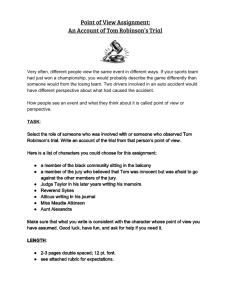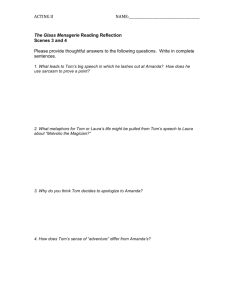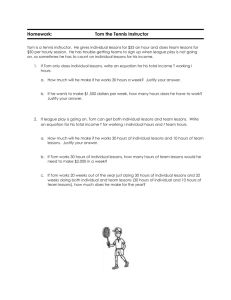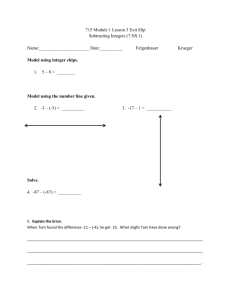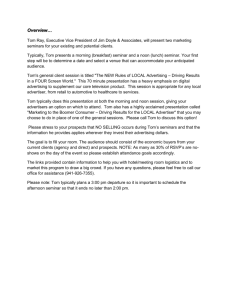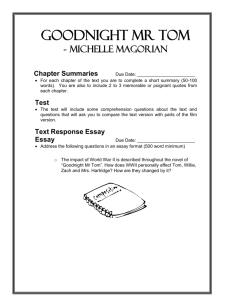PSYC415 Theory of Mind Development
advertisement
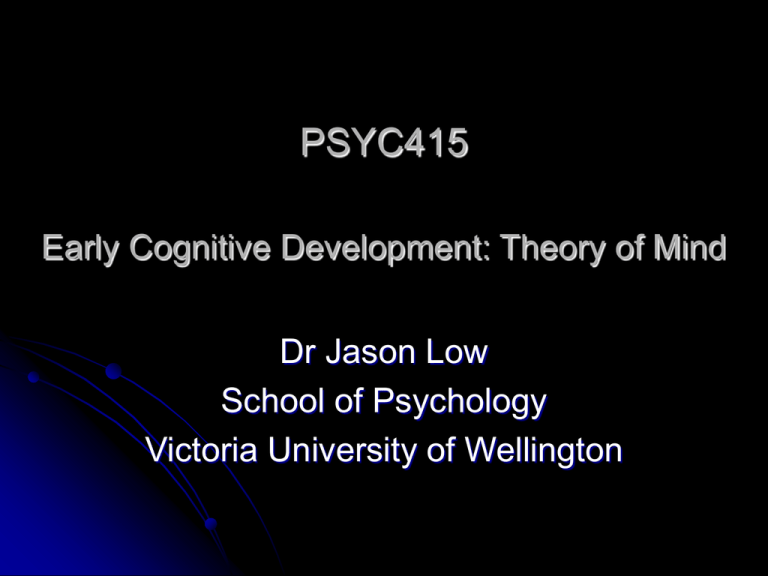
PSYC415 Early Cognitive Development: Theory of Mind Dr Jason Low School of Psychology Victoria University of Wellington What is theory of mind (ToM)? The most liveliest area of research Wellman et al. (2001): in 1998, around 178 studies on ToM (more and more every year) How did it get started? Piaget: children begin development by being egocentric (e.g., visual perspective) (why was Piaget’s theoretical perspective abandoned?) How did ToM research start? Premack and Woodruff (1978) in Behavioural and Brain Sciences – do chimps have a theory of mind? How do we test for ToM? Unexpected Transfer Task first suggested by Bennett (1978), Dennett (1978) & Harman (1978) FB Tasks Wimmer & Perner (1983): used unexpected transfer situation to test false belief understanding in young children Other tests of false beliefs were soon followed: unexpected contents (which also tests for representational change); appearance-reality Theories and antecedents Theory theory account (Gopnik & Wellman, 1994; Gopnik & Meltzoff, 1997) (an informal everyday framework that changes in steps from desire based to desire-belief based to adult-belief) Harris (1992) – simulation theory (children compute mental states through role taking) (think of simulation like empathy) (what develops is accuracy of simulations) Modularity account (Leslie, 1994) – development in terms of neurological maturation of successive domain specific and modular mechanisms Modular perspective Represents behaviour in terms of goals & wants on the basis of certain cues (e.g., selfpropulsion); Outputs dyadic information (e.g., Jason wants the broccoli) ID EDD Detect the presence of eyelike stimuli (visual modality); Represents eye direction as = ‘Agent sees X’; Outputs dyadic information (e.g., Jason sees the broccoli / David sees the broccoli) SAM Represents if self and other are attending to same thing; Interprets behaviour in mentalistic ways Outputs M-representations (Agent-Attitude-Proposition) (David believes that Jason sees/wants the broccoli) ToMM Outputs triadic information (e.g., David sees Jason sees the broccoli); Note that ID is linked to EDD; allows eye direction to be read as rationalistic More on other theories and antecedents Executive function perspective(s) – domain general processing factors such as attention regulation, building and consolidation of statistical regularities; inhibition, rule formulation allow children to acquire ToM Language Adult-child conversations make salient ToM; Language as a vehicle for thought Syntax - aacquisition of the underlying syntactic structure of complement clauses with verbs of communication and mental state (“say”, “tell”, “believe”) enable the representation of false beliefs [e.g., Jason said there was an insect in David’s hair. vs. Jason saw an insect in David’s hair and then went to his PSYC415 class. ] Can thought be fugitive from language? Steps to a meta-representational understanding of mind Explicit understanding of the representation nature of beliefs (e.g., false-belief) and pretence (approx. 4 to 5 years; Understanding link between seeing & knowing, implicit understanding of false belief (approx. 3½ to 4 years Understanding desires, simple emotions, pretence as acting as if (approx. 2½ to 3½ years) Precursors to ToM: shared attention, directed eye gaze, monitoring intent of others (approx. 9mths to 2½ years) Where are differences and similarities in ToM development located? Intra-species (neurotypical development and autism) Inter-species (primates and birds) What do these differences and similarities teach us about: (1) whether ToM is modular or domain general; (2) extent of ToM development being continuous and/or discontinuous (3) the evolutionary roots of ToM and in what ways might interspecies context (e.g., cooperation vs competition; food vs. abstract reward) support ToM-like display?; (4) whether language is necessary and sufficient (or necessary but insufficient) for higher-order rational thought?

